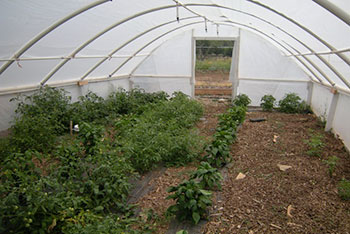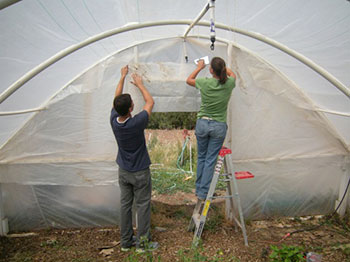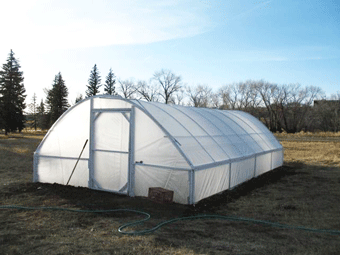Hoop House Greenhouses

Extension
The RAIPAP program started working with cold frame high tunnels and growing production methods 15 years ago to help our clientele extend their growing and production season in northern New Mexico. In the north the season for growing is limited and with a longer growing season more income return is generated for our farm families.
Cold frame high tunnels are economically constructed structures that provide a defense from the environment. They can help by providing protection from the outside elements, retaining heat for plant growth, and also providing shade for some crops. With the use of these structures economic benefits are increased crop yields, improved quality of produce, reduced disease problems and decreased pest problems.
More management is required for positive results but benefits also increase.
See Cooperative Extension Service Resources on Hoop Houses.

Research
After the construction of so many hoop houses around the region, it became clear that growers needed science-based production information about hoop house yields, temperatures, and crop choices. See the Research on Project page. In addition, producer input at an NMSU-Alcalde strategic planning meeting established the need for year-round vegetable production research. Using this information, our group applied to the Western Sustainable Agriculture Research and Education program of USDA and were awarded funding.
In this project we evaluated in detail three passive-solar hoop house designs (of different expense and heat-retention capacities) across three years and different climatic zones for their potential to profitably produce winter vegetables. We use the term hoop house or "high tunnel" to refer to plastic-covered, walk-in, non-permanent structures that use no supplemental or artificial heat source to create suitable conditions for crop production.

These units will be relatively inexpensive with the goal of making winter production opportunities available to resource-limited producers who make up the great majority of our producer clientele. Organically managed lettuce and spinach were planted from October to November in the tunnels at nine study sites in AZ, CO, and NM that reflected a range of agro-climatic zones from cold and short season (north and/or high elevation) to warm and long season (south).
Tunnel temperature and photosynthetically active radiation (PAR) data were collected to help growers select the appropriate tunnel design and crop/variety for their climate. Crop yields and economic analyses help to determine productivity and profitability potential. Resources produced from this project continue to be produced and are provided on the Research on Project page of this website.